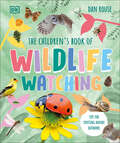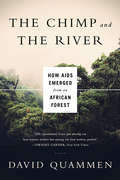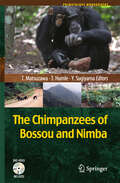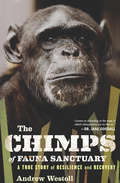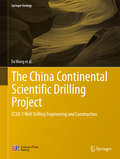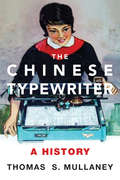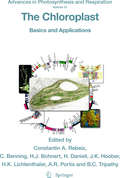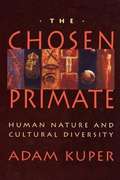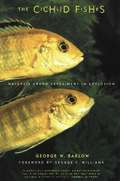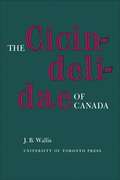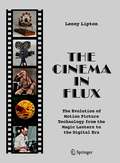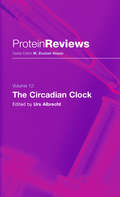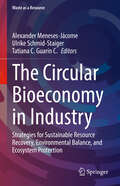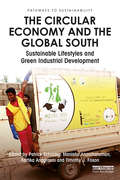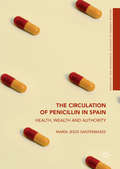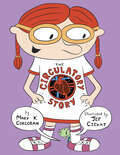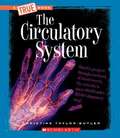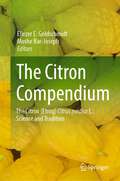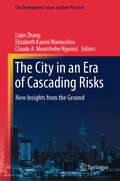- Table View
- List View
The Children's Book of Wildlife Watching: Tips for Spotting Nature Outdoors
by Dan RouseGet to know the wildlife in your garden with this handy guide, featuring craft activities to attract and help your outdoor friends.Make a difference to the local wildlife with the ideas and tips in this informative, hands-on book. Help the animals around you by creating a safe place where they can thrive. Discover how important these creatures are to the environment.Activities will help you get up-close to nature in a safe and responsible manner, whether it's by studying creepy-crawlies, pond dipping, or creating a mammal tracker. You can even design your own garden, with tips on planting the right plants to create a safe space for animals.With plenty of advice from the brilliant wildlife expert and TV personality Dan Rouse, this fun yet educational book is a perfect introduction to animal conservation and protection. The Children's Book of Wildlife celebrates local habitats and teaches children about the challenges animals face and what we can do to help. Whether you love nature, enjoy gardening, or simply want to do your bit to help local wildlife, this delightful book is full of practical information and fun activities.Soon you will know all about mammals, creepy-crawlies, amphibians, reptiles, and birds, and their needs. Watch as they visit your local area! How many animals can you spot?
The Chimp and the River: How AIDS Emerged from an African Forest
by David QuammenIn this "frightening and fascinating masterpiece" (Walter Isaacson), David Quammen explores the true origins of HIV/AIDS. The real story of AIDS--how it originated with a virus in a chimpanzee, jumped to one human, and then infected more than 60 million people--is very different from what most of us think we know. Recent research has revealed dark surprises and yielded a radically new scenario of how AIDS began and spread. Excerpted and adapted from the book Spillover, with a new introduction by the author, Quammen's hair-raising investigation tracks the virus from chimp populations in the jungles of southeastern Cameroon to laboratories across the globe, as he unravels the mysteries of when, where, and under what circumstances such a consequential "spillover" can happen. An audacious search for answers amid more than a century of data, The Chimp and the River tells the haunting tale of one of the most devastating pandemics of our time.
The Chimpanzees of Bossou and Nimba
by Tatyana Humle Tetsuro Matsuzawa Yukimaru SugiyamaThe chimpanzees of Bossou in Guinea, West Africa, form a unique community which displays an exceptional array of tool use behaviors and behavioral adaptations to coexistence with humans. This community of Pan troglodytes verus has contributed more than three decades of data to the field of cultural primatology, especially chimpanzees' flexible use of stones to crack open nuts and of perishable tools during foraging activities. The book highlights the special contribution of the long-term research at Bossou and more recent studies in surrounding areas, particularly in the Nimba Mountains and the forest of Diécké, to our understanding of wild chimpanzees' tool use, cognitive development, lithic technology and culture. This compilation of research principally strives to uncover the complexity of the mind and behavioral flexibility of our closest living relatives. This work also reveals the necessity for ongoing efforts to conserve chimpanzees in the region. Chimpanzees have shed more light on our evolutionary origins than any other extant species in the world, yet their numbers in the wild are rapidly declining. In that sense, the Bossou chimpanzees and their neighbors clearly embody an invaluable cultural heritage for humanity as a whole.
The Chimps of Fauna Sanctuary: A True Story of Resilience and Recovery
by Andrew WestollThe &“moving&” true story of a woman fighting to give a group of chimpanzees a second chance at life (People). In 1997, Gloria Grow started a sanctuary for chimps retired from biomedical research on her farm outside Montreal. For the indomitable Gloria, caring for thirteen great apes is like presiding over a maximum-security prison, a Zen sanctuary, an old folks&’ home, and a New York deli during the lunchtime rush all rolled into one. But she is first and foremost creating a refuge for her troubled charges, a place where they can recover and begin to trust humans again. Hoping to win some of this trust, journalist Andrew Westoll spent months at Fauna Farm as a volunteer, and in this &“incisive [and] affecting&” book, he vividly recounts his time in the chimp house and the histories of its residents (Kirkus Reviews). He arrives with dreams of striking up an immediate friendship with the legendary Tom, the wise face of the Great Ape Protection Act, but Tom seems all too content to ignore him. Gradually, though, old man Tommie and the rest of the &“troop&” begin to warm toward Westoll as he learns the routines of life at the farm and realizes just how far the chimps have come. Seemingly simple things like grooming, establishing friendships and alliances, and playing games with the garden hose are all poignant testament to the capacity of these animals to heal. Brimming with empathy and entertaining stories of Gloria and her charges, The Chimps of Fauna Sanctuary is an absorbing, bighearted book that grapples with questions of just what we owe to the animals who are our nearest genetic relations. &“A powerful look at how we treat our closest relatives.&” —The Plain Dealer &“I knew the prison-like conditions of the medical research facility from which Gloria rescued these chimpanzees; when I visited them at their new sanctuary I was moved to tears. . . . Andrew Westoll is a born storyteller: The Chimps of Fauna Sanctuary, written with empathy and skill, tenderness and humour, involves us in a world few understand. And leaves us marveling at the ways in which chimpanzees are so like us, and why they deserve our help and are entitled to our respect.&” —Dr. Jane Goodall &“This book will make you think deeply about our relationship with great apes. It amazed me to discover the behaviors and feelings of the chimpanzees.&” —Temple Grandin, author of Animals in Translation
The China Continental Scientific Drilling Project
by Wei Zhang Da Wang Xiaoxi Zhang Guolong Zhao Ruqiang Zuo Jialu Ni Gansheng Yang Jun Jia Kaihua Yang Yongyi Zhu Wenwei Xie Wenjian Zhu Peifeng Zhang Lasheng Fan Jianliang Ye Yongping WangThis book comprehensively introduces the drilling theory and practice behind CCSD-1 well drilling, the first stage of a key national scientific engineering project of China. In addition to access to variety of data and information accumulated decade during the project's decade-long operation, readers also gain insight into state-of-the-art techniques and most recent achievements in China's scientific drilling industry. Specifically, this work introduces the drilling engineering design, well site construction, and equipment and construction situation. It also provides a minute description on the new techniques that were developed for tackling the technical difficulties, expounds in detail the core drilling techniques for hard rock deep well, and treats diamond core drill bits, reaming drilling techniques in hard crystalline rocks, well-deviation control techniques for strong dipping strata, and much more. In summary, this book offers a valuable resource for engineers and technicians who engage in scientific drilling and a variety of resource drilling engineering; teachers and students who are interested in this field will also gain plentiful information. Prof. Da Wang, the former deputy director of China Geological Survey, was the director of the Engineering Centre, chief engineer and drill-site general director of China Continental Scientific Drilling Project.
The Chinese Oil Industry
by Charles A. Hall Lianyong Feng Jianliang Wang Yan HuThe Chinese Oil Industry: History and Future presents a wealth of tables and figures with new data on Chinese fossil fuel production and consumption, together with a peak oil model to forecast future trends in energy supply and demand. Energy experts in China and the United States provide you with a unique overview of the entire Chinese oil industry. The authors discuss trends in production and consumption of global significance through to the middle of the 21st century, including the energy returned on energy invested (EROI) for China's oil and gas. The role of oil in the industrialization of China is described as are four phases in the history of the Chinese oil industry. Detailed coverage of resources and exploration, pipeline development, refining and marketing, petroleum and natural gas pricing policies, and international cooperation is followed by consideration of conservation, renewable energy, and environmental impact. The authors also address the importance of coal and the probable future of coal production. - Offers a comprehensive view of the Chinese oil industry - Presents new and previously unpublished data - Covers history and future trends in production and consumption - Introduces a new peak oil model for China - Discusses EROI trend of oil and natural gas and its consequences for the Chinese economy - Written from an objective viewpoint by leading energy experts
The Chinese Typewriter: A History (The\mit Press Ser.)
by Thomas S. MullaneyHow Chinese characters triumphed over the QWERTY keyboard and laid the foundation for China's information technology successes today.Chinese writing is character based, the one major world script that is neither alphabetic nor syllabic. Through the years, the Chinese written language encountered presumed alphabetic universalism in the form of Morse Code, Braille, stenography, Linotype, punch cards, word processing, and other systems developed with the Latin alphabet in mind. This book is about those encounters—in particular thousands of Chinese characters versus the typewriter and its QWERTY keyboard. Thomas Mullaney describes a fascinating series of experiments, prototypes, failures, and successes in the century-long quest for a workable Chinese typewriter. The earliest Chinese typewriters, Mullaney tells us, were figments of popular imagination, sensational accounts of twelve-foot keyboards with 5,000 keys. One of the first Chinese typewriters actually constructed was invented by a Christian missionary, who organized characters by common usage (but promoted the less-common characters for “Jesus" to the common usage level). Later came typewriters manufactured for use in Chinese offices, and typewriting schools that turned out trained “typewriter girls” and “typewriter boys.” Still later was the “Double Pigeon” typewriter produced by the Shanghai Calculator and Typewriter Factory, the typewriter of choice under Mao. Clerks and secretaries in this era experimented with alternative ways of organizing characters on their tray beds, inventing an input method that was the first instance of “predictive text.”Today, after more than a century of resistance against the alphabetic, not only have Chinese characters prevailed, they form the linguistic substrate of the vibrant world of Chinese information technology. The Chinese Typewriter, not just an “object history” but grappling with broad questions of technological change and global communication, shows how this happened.A Study of the Weatherhead East Asian InstituteColumbia University
The Chloroplast
by Constantin A. Rebeiz Henry Daniell Archie R. Portis Baishnab C. Tripathy Christoph Benning Hans J. Bohnert Hartmut K. Lichtenthaler J. Kenneth HooberThe world population is expected to increase to 9 billion by the year 2050 which will generate food and fuel shortages. Since it will be difficult to increase the land area under cultivation without serious environmental consequences, higher productivity for biomass is required. Improvement in photosynthetic efficiency would require increased knowledge and deeper understanding of :(a) the biosynthesis of photosynthetic membrane components such as hemes, chlorophylls, carotenoids, quinones, and lipids; (b) photosynthetic membrane apoprotein biosynthesis; (c) the biosynthesis and regulation of the assembly of pigment-apoprotein complexes; and (d) the complexities of carbon sensing, biosynthesis and allocation. These goals may be accomplished by bioengineering of chloroplasts with higher photosynthetic efficiency and superior adaptation to various stresses and/or alteration of the kinetic properties of the CO 2 assimilating enzyme, Rubisco. Advances towards this goal are addressed in this volume that will foster cooperation between biochemists and molecular biologists, scientists involved in photosynthesis research and biotechnologists involved in plant and plastid genomics and transformation. We envision future research to focus attention on "Chloroplast Bioengineering" as an integrated novel field of research. This book is designed for graduate students and researchers in chlorophyll metabolism, integrative plant biology, plant physiology, plant biochemistry, plant molecular biology, biotechnology, bioenergy and biofuels.
The Choanoflagellates
by Barry S. C. LeadbeaterChoanoflagellates have three distinctive claims to fame: they are the closest, living, unicellular relatives of animals; they are a major component of aquatic microbial foodwebs; and one group is remarkable for its siliceous basket-like coverings. This landmark book offers a unique synthesis of over forty years of choanoflagellates research. Key areas are covered, from the phylogenetic evidence supporting the sister-group relationship between choanoflagellates and Metazoa, to choanoflagellate distribution and diversity in marine and freshwater environments. The structure and assembly of choanoflagellate loricae is also presented together with a full discussion of a novel example of 'regulatory evolution', suggesting that the switch from nudiform to tectiform cell division and lorica production was achieved by a sudden reorganisation of existing structures and mechanisms. Providing an authoritative summary of what is currently known about choanoflagellates, this title will serve as a foundation upon which future research and discussion can take place.
The Chocolate Voyage (Little Golden Book)
by Dave Aikins Tish RabeWhen the Cat in the Hat eats Nick's last piece of chocolate, the gang visits the Forest of Coco-a-licious to learn to make their own. There they discover that chocolate is made from cocoa beans which grow on trees--and that the raw beans actually taste pretty awful! Undeterred, the gang help harvest, dry, and roast the beans, separate the cocoa butter and liquids, and cook the mixture with sugar to make the sweet confection we all know and love. A perfectly tasty read for any time of the year, The Chocolate Voyage is ideal for Christmas, Valentine's Day, Easter, Halloween--any time chocolate is on the menu! Fans of the hit PBS Kids' television show The Cat in the Hat Know a Lot About That! will gobble this one up!
The Chosen Primate: Human Nature and Cultural Diversity
by Adam KuperThe great debates about human origins, cultural history, and human nature confront us with two opposing images of human beings. One view emphasizes biology, the other emphasizes culture as the foundation of human behavior. In The Chosen Primate, Adam Kuper reframes these debates and reconsiders the fundamental questions of anthropology. Balancing biological and cultural perspectives, Kuper reviews our beliefs about human origins, the history of human culture, genes and intelligence, the nature of the gender differences, and the foundations of human politics.
The Cichlid Fishes: Nature's Grand Experiment in Evolution
by George W. BarlowCichlid fishes are amazing creatures. In terms of sheer number of species, they are the most successful of all families of vertebrate animals, and the extent and speed with which they have evolved in some African lakes has made them the darlings of evolutionary biologists. With warmth and wit, Barlow describes the remarkably high intelligence of these fishes, their complex mating and parenting rituals, their bizarre feeding and fighting habits, and their highly unusual adaptations. A celebration of their diversity, The Cichlid Fishes is also a marvelous exploration of how these animals might help resolve the age-old puzzle of how species arise and evolve.
The Cicindelidae of Canada (The Royal Society of Canada Special Publications)
by J. B. WallisThe bright colours and fascinating ways of this small but important group of insects attract immediate attention. Cicindelidae, or tiger beetles, are frequently encountered, but they are difficult to capture, since they are alert and elusive, and still more difficult to identify. This intensive study of the distinguishing characteristics, geographical distribution and variation, and habits and habitats of tiger beetles in Canada—the culmination of the author's main interest for many years—will provide a much-needed reference work. Studies of insect families are scarce, and professional and amateur entomologists alike will find this book a most useful aid in their investigations and a stimulus to further research.
The Cinema in Flux: The Evolution of Motion Picture Technology from the Magic Lantern to the Digital Era
by Lenny LiptonThe first of its kind, this book traces the evolution of motion picture technology in its entirety. Beginning with Huygens' magic lantern and ending in the current electronic era, it explains cinema’s scientific foundations and the development of parallel enabling technologies alongside the lives of the innovators. Product development issues, business and marketplace factors, the interaction of aesthetic and technological demands, and the patent system all play key roles in the tale. The topics are covered sequentially, with detailed discussion of the transition from the magic lantern to Edison’s invention of the 35mm camera, the development of the celluloid cinema, and the transition from celluloid to digital. Unique and essential reading from a lifetime innovator in the field of cinema technology, this engaging and well-illustrated book will appeal to anyone interested in the history and science of cinema, from movie buffs to academics and members of the motion picture industry.
The Circadian Clock
by Urs AlbrechtThe purpose of this volume is to provide historical and current information about the circadian clock, molecular properties of clock components and their roles in health and disease. The Circadian Clock aims to give an integrated view how the biochemistry and physiology of an organism is organized over the 24 hours of a day and how disturbance of clock function can lead to disease. Outline: - Historical overview - Transcriptional Regulation of circadian clocks - Non-Image Forming Photoreception - Interplay Between Circadian Clocks and Metabolism - Clocks, Cell Cycle and Cancer - Circadian Neural Networks - Circadian Neural Networks - Circadian Clocks and Sleep a) Clocks and Sleep in animals b) Homeostatic and Circadian Regulation of Human Sleep - Clocks, Brain Function and Dysfunction - Systems Biology and Modeling of Circadian Rhythms - Comparative Clocks.
The Circular Bioeconomy in Industry: Strategies for Sustainable Resource Recovery, Environmental Balance, and Ecosystem Protection (Waste as a Resource)
by Alexander Meneses-Jácome Ulrike Schmid-Staiger Tatiana C. Guarín C.This book serves as a starting point for readers to understand the concepts of the circular economy and bioeconomy and how they can be applied to industrial processes. The notion of having eco-friendly industries is a recent development, with a growing interest in the environmental impact of industrial practices, particularly with regard to resource recovery practices for valuable nutrients and byproducts, which aligns with the circular economy and bioeconomy concepts that aim to establish a "continuous flow of materials." Currently, the focus is on studying the environmental impact and developing strategies to achieve a balance with water ecosystems for sustainable and equitable coexistence. The success of these concepts will depend on a robust framework that evaluates the environmental trade-offs and co-benefits of improving industry practices to enhance ecosystem protection. This book introduces circular economy practices in industry, along with tips, procedures, recommendations, and lessons learned.
The Circular Economy and the Global South: Sustainable Lifestyles and Green Industrial Development (Pathways to Sustainability)
by Patrick Schröder Manisha Anantharaman Kartika Anggraeni Timothy FoxonThe circular economy is a policy approach and business strategy that aims to improve resource productivity, promote sustainable consumption and production and reduce environmental impacts. This book examines the relevance of the circular economy in the context of developing countries, something which to date is little understood. This volume highlights examples of circular economy practices in developing country contexts in relation to small and medium enterprises (SMEs), informal sector recycling and national policy approaches. It examines a broad range of case studies, including Argentina, Brazil, China, Colombia, India, Indonesia, Kenya, South Africa, and Thailand, and illustrates how the circular economy can be used as a new lens and possible solution to cross-cutting development issues of pollution and waste, employment, health, urbanisation and green industrialisation. In addition to more technical and policy oriented contributions, the book also critically discusses existing narratives and pathways of the circular economy in the global North and South, and how these differ or possibly even conflict with each other. Finally, the book critically examines under what conditions the circular economy will be able to reduce global inequalities and promote human development in the context of the Sustainable Development Goals. Presenting a unique social sciences perspective on the circular economy discourse, this book is relevant to students and scholars studying sustainability in economics, business studies, environmental politics and development studies.
The Circulation of Penicillin in Spain: Health, Wealth and Authority (Medicine and Biomedical Sciences in Modern History)
by María Jesús SantesmasesThis book reconstructs the early circulation of penicillin in Spain, a country exhausted by civil war (1936–1939), and oppressed by Franco’s dictatorship. Embedded in the post-war recovery, penicillin’s voyages through time and across geographies – professional, political and social – were both material and symbolic. This powerful antimicrobial captivated the imagination of the general public, medical practice, science and industry, creating high expectations among patients, who at times experienced little or no effect. Penicillin’s lack of efficacy against some microbes fueled the search for new wonder drugs and sustained a decades-long research agenda built on the post-war concept of development through scientific and technological achievements. This historical reconstruction of the social life of penicillin between the 1940s and 1980s – through the dictatorship to democratic transition – explores political, public, medical, experimental and gender issues, and the rise of antibiotic resistance.
The Circulatory Story
by Jef Czekaj Mary K. CorcoranHumorous text paired with comic illustrations, brings anatomy and science of the body to life for young readers in this exploration of the circulatory system. From the author and illustrator of THE QUEST TO DIGEST comes another playful way to learn about the body and its inner workings. Readers follow a red blood cell on its journey through the heart, lungs, veins, arteries, capillaries, and more, as they see how the body combats disease, performs gas exchanges, and fights plaque. This whimsical glimpse into the human body is fun and informative, perfect for the classroom or the home, and is sure to please the most curious of readers.
The Circulatory Story
by Mary CorcoranSimple, humorous text and comic illustrations explain the basics of the circulatory system--the systemic, pulmonary, and coronary circuits. Readers follow a red blood cell on its journey through the body, and in the process learn how the body combats disease, performs gas exchanges, and fights plaque.
The Circulatory System (True Books)
by Christine Taylor-ButlerDid you know that your nerve impulses are 1,000 times SLOWER than your computer? Or that it's normal to fart - as often as 20 times a day? Get the buzz on health and the human body with this fun and fascinating series.
The Circulatory System (Your Body Systems Ser.)
by Rebecca PettifordOur bodies contain a super highway of blood vessels that carry nutrients, waste, and much more from our heads to our toes. This network is the circulatory system! Beginning with a deep breath in, this fact-filled title uses easy-to-follow text and diagrams to allow readers to dive inside the bodys circulatory system! The human body is a complex being made up of systems that keep us alive and moving! In this series, readers will dive into the bodys systems though engaging, leveled text and related diagrams that follow the parts and functions of each system. Get a microscopic view inside the body with A Closer Look, and put new knowledge into action with a hands-on activity. Check out what is happening inside the body with each title!
The Citron Compendium: The Citron (Etrog) Citrus medica L.: Science and Tradition
by Moshe Bar-Joseph Eliezer E. GoldschmidtThis comprehensive book covers the theoretical and practical aspects of citron trees and fruit. The citron (Citrus medica L.), one of the three primary species ancestral to most citrus types, is used for traditional medicine and is highly revered in the Jewish religion during the Tabernacles feast, referred to by the name 'Etrog'. This book’s three sections address biology (botany, genomics, Chinese and Mediterranean citrons, diseases, pests, and horticulture), tradition (Talmudic discourse, mysticism, medicine, literature, art, food, and beverages) and history (archaeology, trade, grafting controversies); these sections are supplemented by a glossary and pictorial album. The 22 chapters, some new and some translated and considerably expanded from the 2018 Hebrew edition, were written by world-renowned specialists from Israel, Italy, France, the U.S.A., China and Australia. The book is written in an accessible scientific style aimed at a wide range of readers.
The Citrus Genome (Compendium of Plant Genomes)
by Alessandra Gentile Stefano La Malfa Ziniu DengThis book reviews how the release of the citrus genome facilitates the investigation of ancestral species, the study of their complex biological features, and the genetic basis of agronomic traits of paramount importance for their sustainable cultivation. The first chapters discuss citrus origin and distribution, and the economic importance and varietal composition of the cultivated species, providing an overview of citrus and related genera genetic resources. The book then describes the role of traditional breeding techniques (for scion and rootstocks) as well as the potential of genomic breeding and innovative protocols for biotechnological approaches. The second part provides essential information on the genus Citrus, the attributes of pure citrus species, genetic admixtures, hybrids and citrus relatives, and on the horticultural classification of cultivated species, varieties and rootstocks. The third part then focuses on the different molecular mechanisms, covering various aspects of citrus biology, including the role of beneficial compounds of citrus fruits. In addition, it examines the molecular responses of citrus to abiotic stresses and to field and post-harvest diseases. Providing insights gained in recent years, it is a valuable guide for those who are interested in gene discovery, comparative genomics, molecular breeding and new breeding techniques. It is particularly useful for scientists, breeders and students at universities and public sector institutes involved in research for the citrus industry.
The City in an Era of Cascading Risks: New Insights from the Ground (City Development: Issues and Best Practices)
by Liqin Zhang Elizabeth Kanini Wamuchiru Claude A. Meutchehe NgomsiThis book provides unique perspectives into newly changed political and socioeconomic urban landscapes due to COVID-19 in diverse cities and aims to provide ways to improve the resilience of cities using a global perspective, especially in a post-pandemic era. This book is divided into three sections with seventeen chapters overall. It explores the impacts of the COVID-19 on city planning, building, and maintenance; it considers city resilience and what urban risks cities are facing; and it examines urban development from diverse socioeconomic and political perspectives. The book contains multidisciplinary work by authors from China, African nations (Angola, Burundi, Cameroon, Kenya, Morocco, Nigeria), Canada, Italy, Poland, and France. This manuscript provides a global perspective as cities from Africa, China, as well as some developed countries, such as France and South Korea, were used to collect data and information concerning urban development and risks, past, present, and future responses to COVID-19 as well as any other pandemics and cities' resilience. This book is a valuable asset to urban researchers, urban city planners, urban policymakers, public officials, undergraduates, and postgraduates interested in a comprehensive comparison between diverse socioeconomic and political cities with a unique global and post-pandemic perspective in order to improve urban city resilience.
